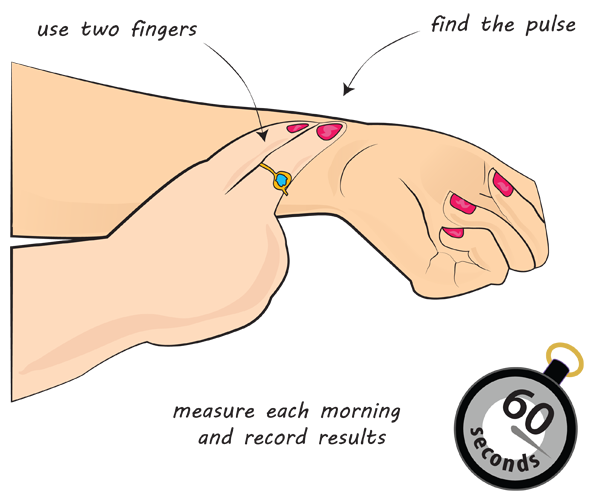Home Fitness Tests
Resting Heart Rate
There is a relationship between resting heart rate and fitness - as you get fitter your resting heart rate often goes down. Also, regularly measuring your resting heart rate is a good way to monitor your health and the body’s response to fitness training. Here are details for conducting the Resting Heart Rate Test. This is one of the 10 tests included in the Home Fitness Test Manual. See the list of other Fitness Tests you can do at home.
![]()
Equipment Needed (see more about equipment)
- Timer - you can use your watch with a second hand, or a digital watch with a seconds display.
![]()
Instructions
The measurement of resting heart rate should be taken a few minutes after waking whilst still lying in bed. If you are not able to take your resting heart rate first thing in the morning, make sure you lie down for at least 10 minutes before taking a measurement. Taking the pulse measurement at the wrist is usually the easiest method.
Place your index and middle fingers together on the opposite wrist in line with the index finger, about 2cm (½ inch) on the inside of the joint. Once you find a pulse, count the number of beats you feel within a one minute period.

Get a Baseline Measure
Measure the heart rate each morning for a few weeks. After a while you will get an idea of what your average resting heart rate is. Once a normal resting heart rate level has been established, it becomes easy to determine if significant changes occur.
Heart Rate Changes
During a period of training, small changes in resting heart rate can reflect changes in fitness, or just normal responses to the previous days training load. Resting heart rate can also be affected by ensuing illness, fatigue and overtraining. Also be aware that other factors such as smoking and caffeine, and some medications, can cause changes in resting heart rate. If you find that you resting heart rate is consistently 10 beats per minute or greater above your baseline measurement, you may want to see your doctor.
Results
Normal resting heart rates range anywhere from 40 beats per minute up to 100 beats per minute, with the average resting heart rate for a man 70 and for a woman 75 beats per minute.
As you get fitter, your resting heart rate should decrease. This is due to the heart getting more efficient at pumping blood around the body, so at rest more blood can be pumped around with each beat, therefore less beats per minute are required.
Recording Results
You can use the heart rate recording sheet to plot the heart rate you measure each day, making it easy to see what your base heart rate level is, and to see if there is any deviation from this level.




